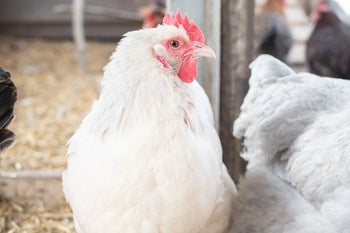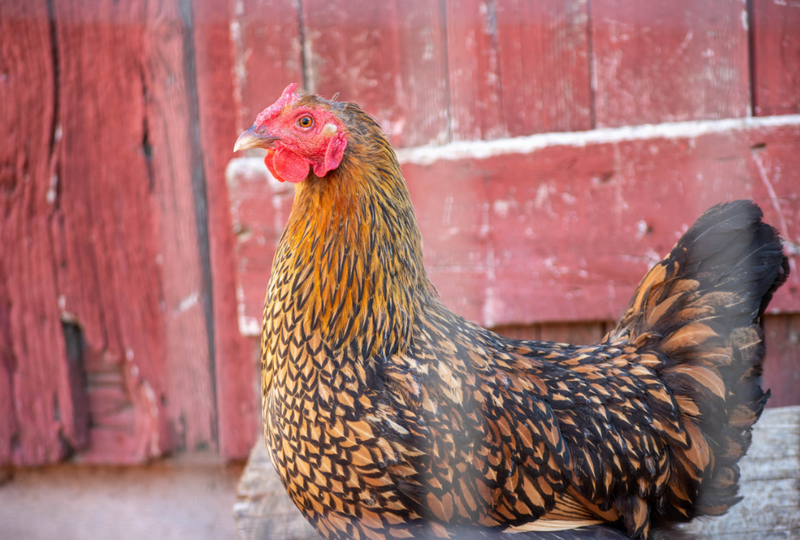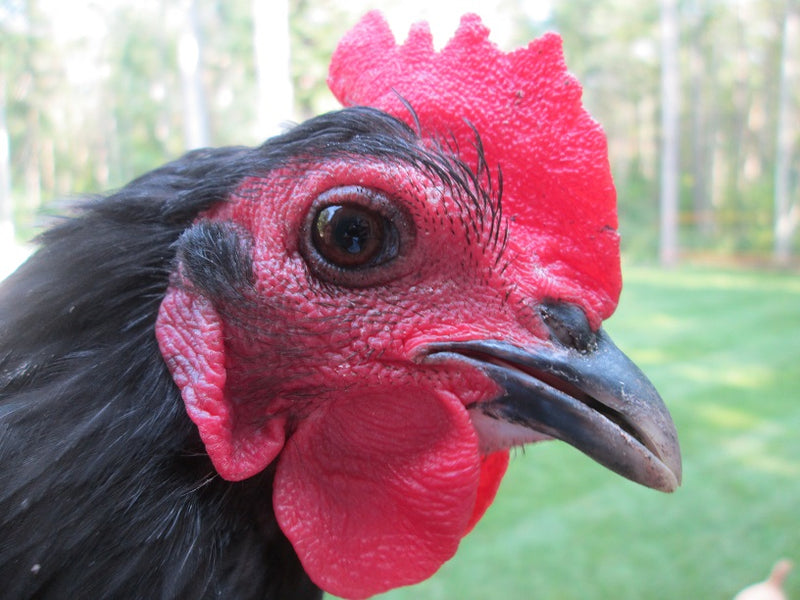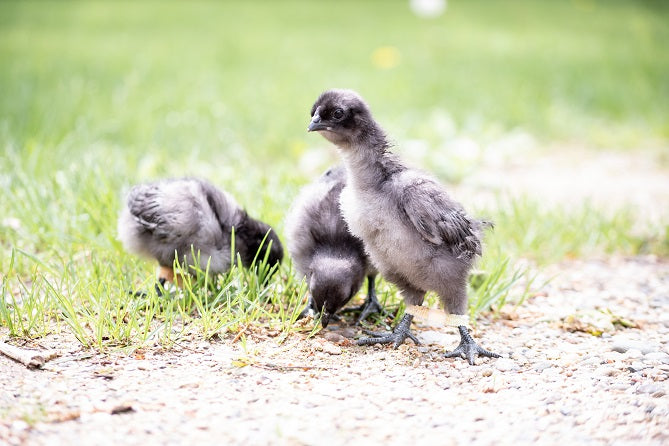Chickens are gifted with a unique anatomical feature: the crop or “craw.” The crop is the gateway to a chicken’s stomach and a vital element to your chicken’s health. Knowing how to recognize, prevent, and treat crop problems in backyard chickens should be on every chicken keeper’s bucket list. An impacted crop is one such ailment that can be fatal to a chicken if not addressed as soon as possible.
Learn how to recognize and treat crop impaction in your chickens, so you can be ready in case one or more of your chickens suffer from this common health concern.
What is Impacted Crop?

Crop impaction in chickens is a condition that affects a chicken’s crop and inhibits it from functioning properly.
An impacted crop occurs when food in the crop becomes compacted and creates a blockage. This blockage prevents the crop from performing its job: sending food onto the gizzard to begin the digestion process. If food can’t move beyond the crop, then a chicken cannot receive proper nutrition from its diet.
The impacted food can also lead to sour crop, be uncomfortable for the chicken, and even lead to suffocation.
How Does Crop Impaction Affect a Chicken?
When a chicken’s crop isn’t functioning properly, it can lead to a great deal of discomfort, pain, and stress for the chicken. An impacted crop can be fatal if the impaction leads to a nutrition deficiency or the impaction presses against the windpipe, leading to suffocation.
What Causes Crop Impaction in Chickens?
Impacted crops are a relatively common problem for backyard chickens. However, this issue tends to crop up more in free-range chickens since they have greater access to long grass. While there are a variety of culprits that cause crop impaction, all come from a chicken’s diet. There are several reasons why food may become compacted in a chicken’s crop:
- Overconsumption of fibrous foods, like long or tough grass.
- Consuming litter such as straw, wood shavings, or too much sand.
- Gorging on too much feed after a period of feed withdrawal.
- Ingesting a foreign object creating a blockage.
Impacted Crop vs Sour Crop
Impacted crop and sour crop are two conditions that inhibit how a chicken’s crop functions. Being able to distinguish between the two is important when it comes to diagnosing a crop problem. Both result from the crop not emptying properly.
- Impacted Crop: food is packed hard so that it cannot move onto the gizzard, crop will feel hard and look large and full
- Sour Crop: food starts to ferment when a pH change occurs in the crop. The crop will look full and feel squishy, the chicken’s breath may smell sour
Sour Crop in Chickens
Sour crop can be caused by an impacted crop if the compacted crop contents cause a pH change and start to ferment. One way to think about sour crop is the food with the crop is going ‘sour,’ hence the name.
For more information on the causes of sour crop and how to prevent it, check out our dedicated sour crop post!
How to Prevent Crop Impaction in Your Chickens

Both impacted crop and sour crop can also be prevented using similar preventative measures. Some specific ways you can prevent impacted crop from becoming a problem:
- Prevent food gorging by ensuring your flock always has free-choice access to their feed.
- Make sure your flock has access to grit to help aid in the process of breaking down tough, fibrous foods.
- Prevent overconsumption of long grasses, fibrous litter, and other hard-to-digest foods.
Diagnosing Crop Impaction in Chickens
Diagnosing an impacted crop in a chicken as quickly as possible can help your chicken avoid the stress and discomfort of not being able to process their food. Additionally, a quick diagnosis can save your chicken’s life.
Symptoms of Crop Impaction in Chickens
A chicken may not show any immediate symptoms of being unwell until the crop blockage starts to cause emancipation due to lack of nutrition. If the impaction is not dealt with, you may notice symptoms, such as
- A lack of droppings (poop)
- Not laying egg
- Weakness
Eventually, the chicken will start acting lethargic and may even have labored breathing if the impaction starts to press against the windpipe.
How to Verify Your Chicken Has a Crop Problem
To diagnose any crop problem, you will want to test to see if the crop is properly emptying overnight. To do so, take away your flock’s food and water after they have roosted in the evening.
In the morning, feel the crop of the chicken that you suspect has a crop ailment. If the crop is small, firm, and hard to distinguish, then the crop has emptied properly. If the crop is still large and feels hard or firm, then the chicken has an impacted crop.
Distinguishing Crop Impaction vs Sour Crop
Even though sour crop and impacted crop are similar conditions, there are some distinguishing features to help you diagnose one versus the other after you perform the step above. For sour crop, the crop will still feel large, but it will be soft and squishy instead of hard.
Keep in mind that impacted crop may lead to sour crop in which case the crop will start to feel squishy and the chicken will have sour-smelling breath.
What To Do for Impacted Crop in Chickens

The sooner you can diagnose impacted crop, the better. An undiagnosed crop impaction can lead to emergency surgery. A chicken who has been dealing with an impacted crop for quite a while will need immediate attention and may need surgery right away, in which case you should consult a vet.
How to Treat a Crop Impaction When Caught Early
Impacted crop that has been caught early enough may be able to be successfully treated at home.
- Start off by quarantining the affected bird. Do not provide any food for 24 hours, but you can provide fresh drinking water. The water may help break up the hard impaction, but be cautious that the condition doesn’t start to turn into sour crop if the contents start to ferment.
- Gently massage the crop to try and help break up the impaction. Giving the chicken a little bit of vegetable oil mixed with warm water can also help break up the blockage.
- Massage the crop as often as you can throughout the day. You will want to massage the crop from the top down so that you don’t stimulate vomiting.
-
Once you see improvement in the condition, then you can offer the chicken some easy-to-digest foods and plenty of fresh water.
Easy to digest foods include:
- Boiled eggs
- Plain yogurt
- Mashed fruit
- Diced or minced veggies
- Watered-down or fermented feed
- As impacted crop improves, the crop will get smaller and will start to feel less hard and more pliable. Continue to monitor the chicken to make sure the crop is completely emptying each night before putting the chicken back out with the flock.
Prevent Crop Impaction with a Healthy Diet
Crop impaction in chickens is quite a serious condition. It occurs when the crop becomes blocked by food that has become so compact, that it verges on a solid mass. The blockage prevents food from continuing on through the digestion process which results in lack of nutrition for the chicken. Untreated, crop impaction can result in suffocation and the loss of your chicken’s life.
Luckily, preventing impacted crop can be easily done with good flock management and a proper diet. Make sure your flock has access to nutritious feed all day and prevent them from eating too much fibrous foods, like long grass or coop litter. A good diet and daily care will keep your backyard flock happy, healthy, and productive!










